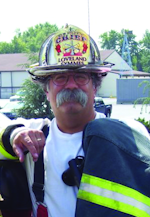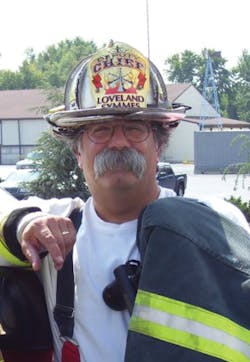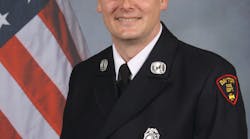Close Calls: Fire Captain Struck Minutes After Arrival - Part 2
Last month’s column featured part one of a report about a close call involving City of Dayton, OH, Fire Department Captain Barry Cron, who was struck by a pickup truck while operating at a traffic accident scene in wintry weather. This month’s conclusion focuses on the lessons learned.
Take a look at these two videos to get more perspective on the incident: “Ohio Fire Captain Barry Cron Survives Crash,” http://www.youtube.com/watch?v=lGv0oNZChck; and “Dayton Fire Captain Barry Cron,” http://www.youtube.com/watch?v=P1DTSUdaLhs.
The following comments are by Captain Barry Cron:
I have had a lot of time to think about the accident and what I would or would not have done differently. Although my department and fellow Dayton firefighters were very supportive of me, I received criticism from afar (and from myself) about why I made the decision to be where I was in the first place. Trust me, nobody is a bigger critic of the incident than me. It took several weeks before I stopped replaying the incident every waking minute in my head, waking up in the middle of the night only to go over it again and again. I would like to explain some of the decisions I made to hopefully let the reader understand the thought process I had. Then he or she can decide whether they were good choices or bad and how they might do it differently.
On arrival of an accident scene, we do, as practice, block all lanes we feel necessary to create a safe zone. We make every effort to angle the apparatus away from the scene and protect the work area as much as possible. On arrival at this scene, we did not angle the ladder. As I stated (in part one), the Dayton Police Department (DPD) had the closest lane blocked, we parked in the second lane and I thought pretty effectively boxed in the scene. In retrospect, I should have directed my driver to block in front of the DPD cruiser, taking both lanes. Even though the additional vehicles that slid into the accident scene were on the other side of the highway, if it had occurred on our side, it’s always better to have a 26-ton vehicle running interference for you rather than a 1½-ton police car. This is something I usually attempt to do, but did not on this run.
Up to the point of the second vehicle impacting, I feel we had a pretty good handle on our scene on our side of the guardrail. I was not allowing our crews on the other side of the guardrail until I was assured we had eastbound shut down, or at least apparatus in place to block for us. It was a fairly routine accident scene with a slight twist as to the position of the vehicle requiring us to work on both sides of the highway.
I think the only question that still lingers is “Why did you put yourself in the position you did?” It’s easy to Monday-morning quarterback and say I should have never approached the truck until I was assured the eastbound lanes were completely closed or blocked. That is a valid argument and I will never argue against it. The only answer I have is, I guess you never really know what you’ll do until presented with a situation.
My intent was to get a quick assessment of the occupant(s) of that truck and get back quickly to formulate the new game plan. Things just happened too quickly. Did I look upstream of the accident scene to assess what traffic was coming and whether there would be a break in the traffic to allow me to more safely approach the truck? Honestly, I still don’t remember whether I did or how effectively I did.
As I have driven through that section of highway many times since, I see that even if I had, a slight rise in the highway would have blocked my vision of oncoming traffic and limited what traffic I had seen to only several hundred feet up the road anyway. Being in the dark, early-morning hours, I may not have seen that rise in the highway. In the few seconds it took to approach the truck and look inside to assess, many vehicles traveling around 50 mph could have crested that rise.
The point I want to make is, most departments are aware of the dangers of working on the roadway, be it highway or neighborhood street. Use proven procedures such as blocking enough lanes to give yourself and incoming crews plenty of safe area to work in. Park your apparatus far enough back from the scene to create an effective safe zone. Even a 20- or 30-ton apparatus can be pushed into the accident scene if a speeding tractor-trailer is the vehicle that loses control and strikes your engine or ladder.
Create as much visibility as possible to oncoming traffic to make them aware of your presence in the street. I have seen fire apparatus on the highway with nothing more than two rotating beacons on the back. In my opinion, that’s not nearly enough emergency lighting. There should be more than adequate emergency lighting on the rear of any emergency equipment.
I think there is a reason why I was spared further injury or death that morning. I thank God for his watchful eye and protective hand. Please study my story and the dashcam video and review your department’s procedures and see where improvements can be made to help keep you safe. I was fortunate and made a quick recovery and was lucky enough to survive mostly unimpaired. So many of our brothers and sister have not. Above all else, please be safe out there.
The following comments are by Dayton Interim Fire Chief Jeffrey L. Payne:
A post-incident analysis was conducted between the Dayton Fire Department training staff and the crews involved in Captain Cron’s incident. The purpose of the analysis was not to point fingers or lay blame. Rather, it is to serve as a learning tool where the entire department can learn from mistakes, and smart practices, made at emergency incidents.
Although the Dayton Fire Department has policies in place addressing highway incidents, policies cannot always address or control responses impacted by environmental factors. Fire officers are expected to make decisions “on their feet” based on their incident size-up and cannot always follow standard operating procedures (SOPs) exactly as written. As fire officers often do, decisions are made and actions taken based on their experience and previous successes during similar conditions. This was the case for Captain Cron; however, the environment and geography produced conditions that created unaccounted for hazards. Fortunately, Captain Cron was able to return to work and give his narrative of the events that occurred.
The following comments and resources are from Chief Goldfeder, following discussion of the incident with Captain Cron:
As you may recall, I was struck by a vehicle on Interstate 71 in the late 1990s. As the captain describes, the run starts out normal and ends up making you realize that things can happen anywhere, on any scene and at any time. If we survive it, get back to work and learn from it, that’s a good thing. And that's the goal of this column.
The best way for us to understand the dangers of working on roadways is to learn from those who have been studying it and, of course, from those who have “been there and done that.” When arriving and operating on a roadway, it may seem as simple as just shutting down a road or blocking it, but there is a system on managing traffic when we are operating.
First, go to the International Association of Fire Fighters (IAFF)/U.S. Fire Administration (USFA) document: Best Practices for Emergency Vehicle and Roadway Operations Safety. It is loaded with case studies, PowerPoint presentations and related materials to help you train your members. The document discusses training, policy development, education and technology to enhance emergency vehicle and roadway safety operations. It is available to you, at no cost, at http://www.iaff.org/hs/evsp/index.html.
Second, download the National Institute for Occupational Safety and Health (NIOSH) bulletin Traffic Hazards to Fire Fighters While Working Along Roadways. This document is a one-pager that you can print out and post in your quarters. It’s a quick, “at-a-glance” document that helps firefighters immediately understand the dangers of roadway operations. This too is available at no cost; find it at http://www.cdc.gov/niosh/docs/2001-143/.
Finally, go to www.respondersafety.com. I’ve been close with the people behind this effort – Steve Austin, Dr. Harry Carter and Jack Sullivan – for many years; they are the “go-to” folks when it comes to roadway survival. Below you will find just some of the information that is available to you, with access to much more so you don’t have to experience what others have – being struck on a roadway.
At www.respondersafety.com, you can create programs as well as continuing education training for all of your members. The site, operated by the Cumberland Valley Volunteer Firemen’s Association (CVVFA) Emergency Responder Safety Institute, through grant funding, is the best way to get the most up-to-date information you need for your department. Listed below is a description of each training and resource category it offers, all at no cost. It also has online training certification programs so your members get needed sitdown training along with practical training.
• Advance Warning – Information on advance-warning equipment and protocols, including traffic-control devices and their deployment
• Blocking/Safe Positioning – Guidance on the use of vehicles to block the activity area to protect emergency responders and victims during an incident response on the roadways
• High-Visibility PPE – Information on high-visibility personal protective equipment (PPE) such as garments, vests, helmets and gloves
• High-Visibility Vehicle Markings – Discussions about high-visibility markings on fire apparatus and other emergency vehicles deployed for traffic incidents
• Highway Lane Designations – The numbering and nomenclature of highway lane designations
• Incident Command System (ICS) and National Incident Management System (NIMS) – Makes the connection between NIMS/ICS and traffic-incident management, following the unified command paradigm and integrating with the work of traffic incident management and planning bodies
• Line-of-Duty Deaths (LODDs) – Data and/or discussions of some aspect of line-of-duty deaths of responders working on roadways
• National Unified Goal – Details the National Unified Goal for Traffic Incident Management, a national policy that encourages state and local transportation and public safety agencies to adopt unified, multi-disciplinary policies, procedures and practices to improve the way traffic incidents are managed on U.S. roadways
• Professional Qualifications/Performance Standards – Explains professional qualifications and performance standards for traffic-control officers, emergency responders who work on highways and traffic-incident management professionals
• Slow-Down and Move-Over Laws – Summarizes the content and status of slow-down and move-over laws in the U.S.
• Public Education – Educates the public about slow-down and move-over laws protecting emergency responders and how to react to emergency vehicles at roadway incidents
• Safety Education Materials – Resources such as posters, handouts and charts that can be used in educational campaigns
• Reports – Official reports related to traffic-incident management issues that are published by agencies, departments and organizations representing emergency response, traffic, transportation and related disciplines
• SOPs/SOGs – Model standard operating procedures (SOPs) and standard operating guidelines (SOGs) to consult when determining what protocols to adopt and how to codify them into a formal document
• Struck-By Incidents – Data on struck-by incidents during roadway responses and/or discuss factors present in struck-by and near-miss incidents
• Traffic-Incident Management – Information on how roadways are best managed in instances of traffic, accidents and planned events
• Training – Suggests learning objectives, provides content, renders technical assistance and gives examples of other training implementations
• White Papers – Background information to help you understand specific issues in traffic control and traffic-incident management
With so many resources available to us at no cost whatsoever, there is no excuse to not have all of our personnel trained and educated on what to do-and not do-when operating on our roadways. The next time someone in your firehouse asks “What’s for training? we have provided the appetizers, entrees and desserts above, thanks to the USFA, IAFF, NIOSH, Responder Safety/CVVFA and Captain Barry Cron. All for free. How ’bout that? Now start devouring.
FIREFIGHTER FATALITIES ON HIGHWAYS
• March 19, 2012 – Arkansas fire captain killed and firefighter and police officer injured at scene of motor vehicle crash
• Feb. 29, 2012 – California fire captain dies when struck by pickup truck at scene of two traffic incidents
• Sept. 18, 2011 – Iowa firefighter struck and killed while directing traffic at interstate highway incident
• Nov. 13, 2010 – South Carolina firefighter killed and another firefighter seriously injured when struck by vehicle while working at grass fire along interstate highway
• Feb. 12, 2010 – Pennsylvania fire police captain dies after being struck by vehicle on controlled roadway
• June 14, 2008 – North Carolina assistant fire chief killed when struck by tractor-trailer while operating at motor vehicle crash
Source: National Institute for Occupational Safety and Health (NIOSH)
WILLIAM GOLDFEDER, EFO, a Firehouse® contributing editor, has been a firefighter since 1973 and a chief officer since 1982. He is deputy fire chief of the Loveland-Symmes Fire Department in Ohio, an ISO Class 2 and CAAS-accredited department. Goldfeder has served on numerous National Fire Protection Association (NFPA) and International Association of Fire Chiefs (IAFC) committees. He is on the board of directors of the International Association of Fire Chiefs (representing the Safety, Health and Survival Section), National Fallen Firefighters Foundation, September 11th Families Association and National Firefighter Near-Miss Reporting System. Goldfeder and Gordon Graham host the free, non-commercial website www. firefighterclosecalls.com. Goldfeder can be contacted at [email protected]. Part one was in the October issue.

Billy Goldfeder
BILLY GOLDFEDER, EFO, who is a Firehouse contributing editor, has been a firefighter since 1973 and a chief officer since 1982. He is deputy fire chief of the Loveland-Symmes Fire Department in Ohio, which is an ISO Class 1, CPSE and CAAS-accredited department. Goldfeder has served on numerous NFPA and International Association of Fire Chiefs (IAFC) committees. He is on the board of directors of the IAFC Safety, Health and Survival Section and the National Fallen Firefighters Foundation.







